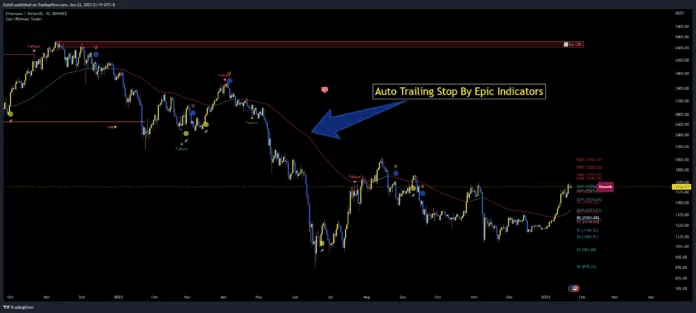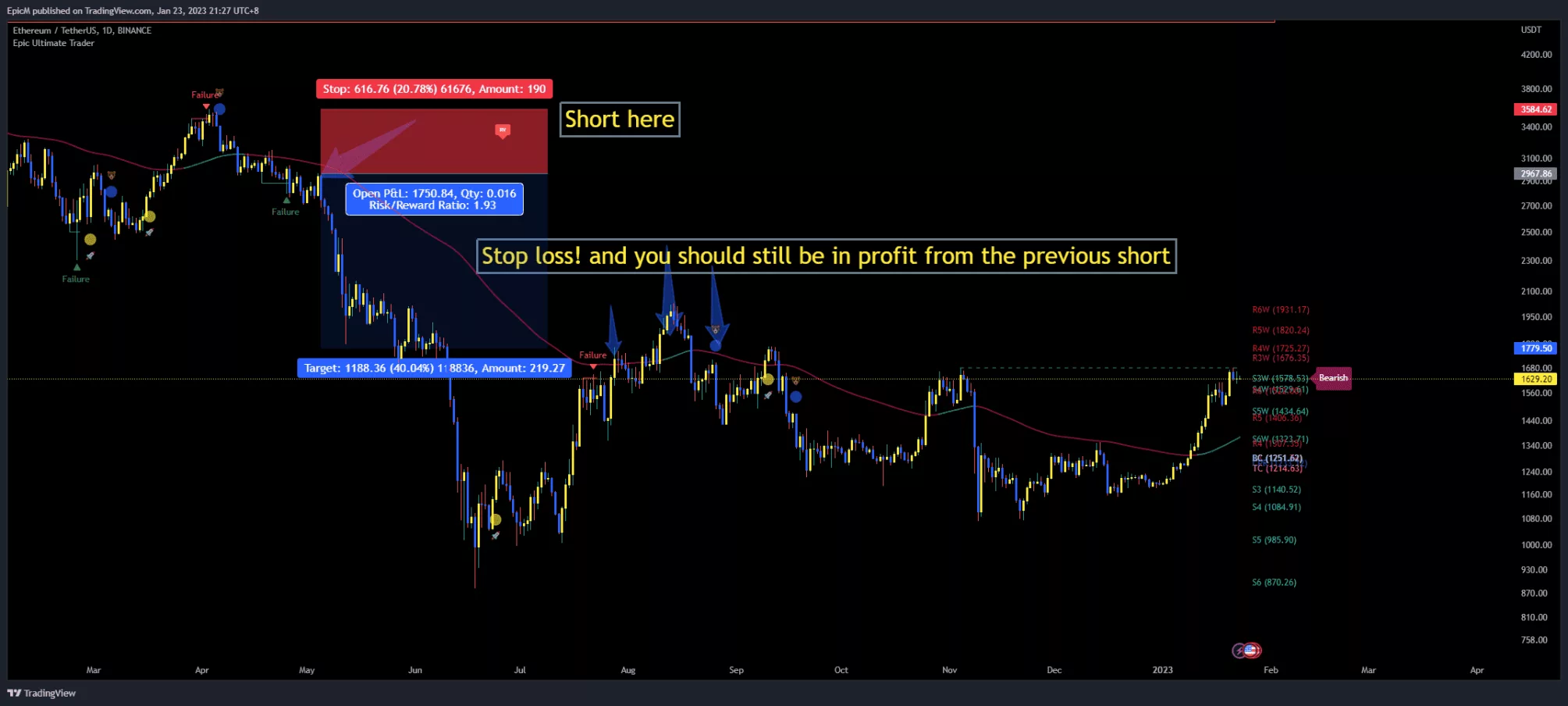Picture this scenario: You’re immersed in an active stock market, observing the prices of stocks skyrocket. The excitement is tangible as your profits achieve record highs – but all of a sudden, the market faces a swift decline. At this crucial turning point, a prompt and efficient reaction becomes necessary, highlighting the significance of trailing stops.
Trailing stops are an invaluable tool used by investors to maximize their profits while still protecting their investments. They can help limit losses while allowing investors to take advantage of any potential gains that present themselves in the markets. In this article, we look at how trailing stops work, and how you can use them to maximize your profits.
For investing, knowledge is power–so let’s explore how trailing stops work and how you can use them to make sure you get the most out of every investment opportunity that comes your way!

Trailing Stop-Loss Orders: The Basics
If you’re looking to maximize your profits in the stock market, understanding trailing stop-loss orders is essential. A trailing stop loss order is a type of stop loss order that follows the price of the stock. As the stock increases in value, the trailing stop loss order follows, giving you the potential for higher returns. It’s an important tool for traders looking to protect their investments and maximize gains.
I set trailing stop losses at a certain percentage or dollar amount below the stock’s current market price. As the stock’s price goes up, so does the trailing stop order. If it drops too much, your position will be closed at a predetermined level – protecting your profits while still allowing you to benefit from any further increases in value.
This helps to manage risk and taking advantage of any unexpected upside movements in price.
So now that we’ve gone over how trailing stop-loss orders work, let’s look at some other types of stop-loss orders and when to use them!
Types Of Stop-Loss Orders And When To Use Them
For trading, stop-loss orders prove to be an invaluable asset for traders to look after their investments and maximizing profits. Understanding when and how to properly use these orders can be the difference between success and failure in the market. In this article, we’ll discuss the different stop-loss orders available and what each one can do for you.
A popular order amongst many traders is a trailing stop loss order. This type of order moves with the security price as it fluctuates, guaranteeing that a long position is not prematurely converted into a market order. The trailing stop will stay at its current level until the security price has reached the stop point, where it becomes a market order and goes for execution. This allows traders to remain secure when markets inevitably change directions periodically without having to worry about monitoring their positions too closely.
Despite being easily carried out with a simple click, setting a stop loss order requires careful consideration and planning of time. Without doing so, traders may lack any kind of profit despite conditions looking favourable during entry.
To prevent this, it is essential that traders identify their risk tolerance levels before setting their limit price away from the current market rate: preferably higher than if they were going short in that same position. Picking the right level ensures that you have enough trading capital left when your position passes beyond profitable territory or exits when it reduces in value rapidly; depending on which direction your security’s price is moving regarding your expectations–either favourably or unfavourably–at p.m EST (4:00 p.m GMT).
Regardless of whether you want to incorporate more aggressive strategies like short-term stops or set limits on losses from each trade, understanding when and how to use different stop-loss orders can bring you closer towards realising your trading goals while mitigating risks along the way.
Doing so helps preserve capital while taking advantage of any potential opportunities in securities prices; enabling more serious swing trades by giving longer holding periods accordingly with bigger rewards awaiting those who exercise patience along with taking calculated risks throughout this process!
A Practical Guide To Using A Trailing Stop Loss Order
Let’s look at an example to understand how a trailing stop loss order works. Say you have bought shares in a company at $$$ and you want to set a trailing stop limit of 10%. As the share price rises, your trailing stop will rise too – up to $$ if the share price drops. This means that if the share price drops back below $$, your order will be triggered and your shares sold automatically.
Trailing stops are a great way to maximize profits because they protect against losses while still allowing you to benefit from any gains in the market. Here are five strategies for maximizing your profits with trailing stops:
• Set smaller trailing stops when the market is volatile
• Use tighter stops when there is strong trend movement
• Monitor your position regularly and adjust accordingly
• Consider increasing your risk tolerance for more potential gains
• Set a maximum loss amount so that you don’t lose too much money if the stock drops.
By implementing these strategies, you can ensure that it well protected your investments while also taking advantage of any potential gains in the market.
Strategies For Maximizing Your Profits With Trailing Stops
Trailing stops are powerful strategies that traders used to maximize their returns from volatile markets. When correctly implemented, these tactics allow traders to lock in profits as securities continue to appreciate without fretting over when it is the most opportune time to exit their position.
A trailing stop order is essentially a buy or sell order within a designated price level of a security. If the security reaches your stop price, then this order is automatically converted into a market order and submitted at the next opportunity when the market opens. If, however, the stock price falls before reaching your stop value, then this market order will not execute – providing much-needed protection against potential losses in case prices move in an opposite direction than expected.
To harness its full potential, it’s essential to set up trailing stops properly based on one’s individual trading strategy and preferences, as well as current market trends. With skillful execution of this trading tactic and tracking of current trends, investors may ensure that even if prices fall sharply because of unforeseen events, their investments remain profitable!
Broker Assisted Trading Basics For Placing A Trailing Stop Limit
For traders aiming to maximize their gains, broker assisted trading strategies that work can be invaluable. A trailing stop limit order is one of the most useful tools at our disposal, as it enables us to set an execution price that moves along with the shifts in the market.
Unlike a traditional stop loss order which closes out positions at pre-determined prices, this feature automatically adjusts to increase profit if the price of a security moves in your favor. Once you have configured your parameters and entered your instructions for this type of trade, your broker can take care of placing market orders whenever relevant market data is gathered. This means you don’t have to constantly monitor any active trades, as your priority will only move if the price moves in a certain direction or surpasses specific thresholds.
Bracket orders and OCO (Order Cancels Order) are other order types available with some brokers which enable us to optimize each trade. Combining all these features gives us a great opportunity to gain more from each position and keep up with unpredictable market forces. Now that we know what is necessary for setting up a trailing stop limit and how it works, let’s get ready to make those trades!
How To Set A Trailing Stop Limit And Take Advantage Of It
Successful trading involves protecting and optimizing profits while limiting losses. Trailing stops use market movements by creating a limit order that tracks the current price for a stock or other asset.
This type of order stays in effect until they trigger it when there is an unexpected shift in the market. By setting up a well-defined trailing stop limit percentage, investors have the potential to maximize profits without exposing themselves to too much risk in fluctuating markets.
Once the pre-determined limit has been surpassed, it will convert the trailing stop into a market order, which provides an opportunity for traders to liquidate their position at or near its best possible price before any further decline occurs in value.
This simple concept of risking only what you are comfortable with allows one to stay ahead of prices while they move favourably and locking in gains at predetermined levels as soon as they dissipate. Setting up trailing stops requires knowledge on how they work and analysis through chart patterns, but can cause effective trade management if done correctly.
Analyzing Chart Patterns With The Help Of A Trailing Stop-Loss Order
Trailing stops are an invaluable tool for traders navigating the stock market as they allow them to take advantage of potential profits while protecting their investments from any sudden losses. A properly defined strategy for when and where to place these orders can help analyze chart patterns and maximize returns.
When setting up a trade using this technique, you will need to decide a limit on potential losses as well as where your initial stop-loss order will be set. The goal is to identify an attainable spot that follows the stock’s performance while creating minimal financial exposure. Once you have selected your entry point, you can then convert it into either a market or limit order with parameters and execute it.
For many investors creating such strategies is essential in making successful trades and maximizing their profits – just remember that if the security’s price surpasses your defined percentages then the order will be converted into a market order which you should closely watch as it may cause unexpected losses because of high volatility. With careful analysis of chart patterns and use of trailing stops, one can be proactive when predicting how original stocks respond to changing markets conditions. This provides traders with greater flexibility, ensuring that their trades are profitable both in flat and volatile markets alike.
Minimizing Risk With Trailing Stops In Trading
Trailing stops are a powerful tool that can minimize risk when trading. A trailing stop is a type of stop loss order which moves as the price of an asset moves. This allows traders to lock in profits while limiting losses if prices reverse. Here’s how you can use them to maximize your profits:
1) First, set a trailing stop loss order which will trail the price at a specific distance or percentage. Some platforms allow you to set multiple levels of trailing stops, so consider this option if available.
2) Monitor the price movements in the market and adjust your trailing stop, making sure not to move it closer than your original level.
3) Finally, once the price reaches your desired target, close out your position and reap the rewards!
Trailing stops are useful if you’re looking for ways to protect yourself from large losses in volatile markets. By using a stop-loss order, you can ensure that you won’t take on too much risk when trading and can still make profits from any successful trades. With their help, you’ll be able to enjoy more peace of mind when investing in stocks or other assets – all without sacrificing potential gains!
Frequently Asked Questions
How Do I Know When To Use A Trailing Stop Loss Order?
Locking in profits on investments can often be quite challenging. Fortunately for investors, however, there’s an order type that can help with this: The Trailing Stop Loss Order. Knowing when to use it can help traders stay ahead of changing market conditions so they don’t miss out on potential profits due to lack of protection.
When activated, this type of order triggers an automated execution once the stocks’s price surpasses set parameters such as a fixed amount or percentage from current levels. As long as prices move in favor of the position, your orders won’t execute yet, allowing opportunities for more profits until the trend reverses, at which point it will instantly go into effect and close the trade for you.
This helps protect against unforeseen dips while still allowing traders ample chances for rewards when conditions are favorable. Investing with Trailing Stops is an invaluable tool necessary for making sure each investment reaches its maximum capacity.
What Are The Risks Of Using A Trailing Stop Loss Order?
Trading with a trailing stop order can be beneficial in generating profits but carries certain dangers. For instance, significant shifts in market conditions can cause your pre-determined targets to be off because of discrepancies between last trade prices and where you set your targets. If stocks rapidly move against your prediction, they may still lose then profits despite setting this type of strategy.
To minimize any losses, it is essential that investors regularly update their trailing stops so they can capture decreasing stock movements. Without doing this, they might end up selling at significantly lower than expected prices when their orders execute. All traders should take care when setting up these orders as they need to consider how much risk they can accept before locking in profit or possibly limiting their losses if the price of the stock moves in an opposite direction instead.
How Do I Set A Trailing Stop Limit?
Managing risk while investing is essential when wanting to increase profits. A great way to do this is by employing a trailing stop limit order. This type of order ensures that someone automatically executed your trades when the stock price moves favorably under your predetermined reference point.
To set this up, investors need to choose an amount or percentage that will be compared to the stock market value. The reference point will then follow any positive movement in the market and act as a ‘stop loss order’ if the stock value drops to a specified level. By making use of trailing stop orders, investors can stay profitable even during tumultuous times without needing to constantly monitor their positions.
What Is The Difference Between A Trailing Stop Limit And A Regular Stop Loss Order?
To illustrate how trading stocks works like riding a roller coaster is to visualize how beneficial trailing stops can be for one’s trading account; much like how safety belts are used for amusement parks rides.
Trailing stops differ from regular stop-loss orders, as regular orders instruct one to sell when prices drop below specified levels, whereas trailed stops sets itself at an adjustable percentage or points below current values; this allows greater potential opportunities for retailers by permitting their trading account appreciate in gains without overexposing themselves when markets start regressing. If users opt to use this tool correctly, it might cause effective asset management, since it helps safeguard both profits and minimizes losses.
However, it is important that investors carefully monitor market movements to accurately align their settings accordingly–once I mastered such ability, then it rewards traders with additional cost effective features like automatically turned into market orders which secures those added income increments when prices fall downwards.
How Often Should I Adjust My Trailing Stop Loss Order?
It’s important to understand how often you should adjust your trailing stop loss order. After all, that’s what will maximize your profits. The key is to find the sweet spot between not adjusting it too frequently and not leaving it for too long without an update.
Adjusting a trailing stop loss order depends on many factors, including the current market conditions, the type of security you’re trading, and your own risk tolerance. If you’re trading in a relatively stable market, it’s best to adjust your trailing stop every few days or weeks. If the market is more volatile or unpredictable, then you may need to adjust it more often. You’ll want to be sure to use technical indicators like moving averages when determining when to update your order as well.
In addition, it’s essential that you assess how much risk you’re comfortable with when setting up a trailing stop loss order. Adjusting too frequently can leave you vulnerable to sudden drops in price, while leaving the order unchanged for too long could cause missing out on potential profits. Finding the right balance is key. Taking some time to research and familiarize yourself with different strategies and techniques can help you determine which approach works best for you and your investments.
Conclusion
In conclusion, using a trailing stop loss order can be an effective way to maximize profits. While it is not without risks, understanding how and when to use them can help you make the most of your investments. The key is to understand the differences between a regular stop loss order and a trailing stop limit, and to adjust your orders as needed.
By taking the time to learn about trailing stops, you might increase your profits while minimizing your losses. However, there is no guarantee that this strategy will be successful for everyone. It’s important to remember that investing always involves some risk, so use caution when deciding about your investments.
Ultimately, deciding whether to use trailing stops depends on individual circumstances and goals. By considering all factors involved in the decision-making process, you can make an informed choice that best suits your needs.







